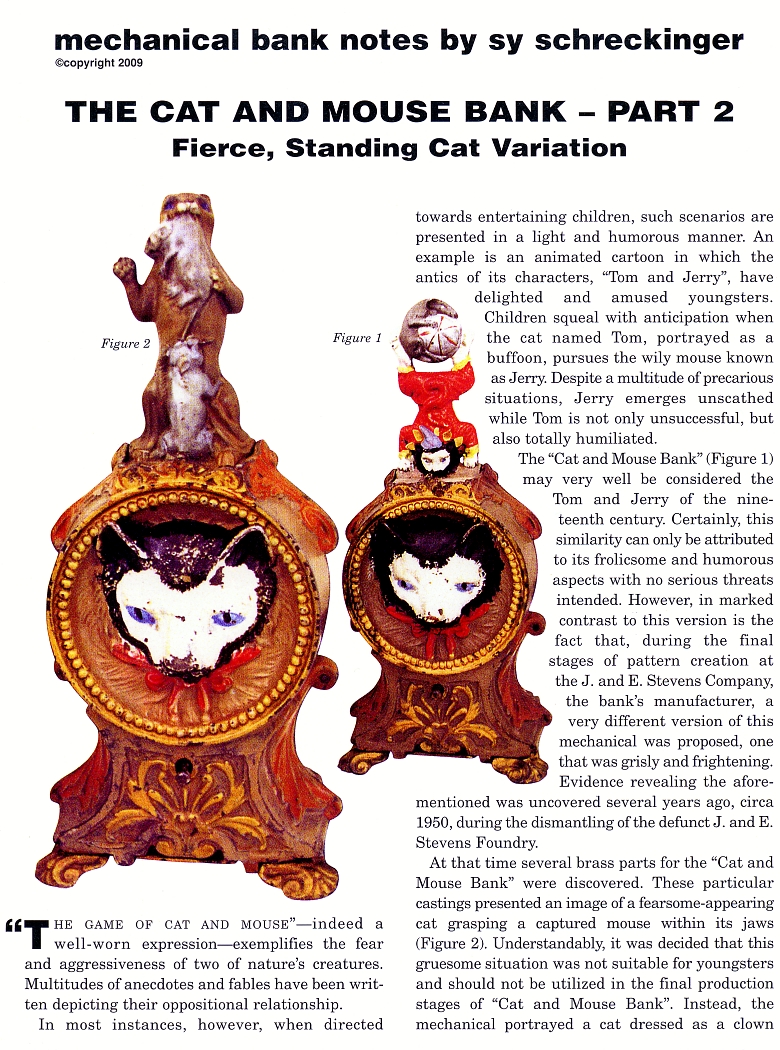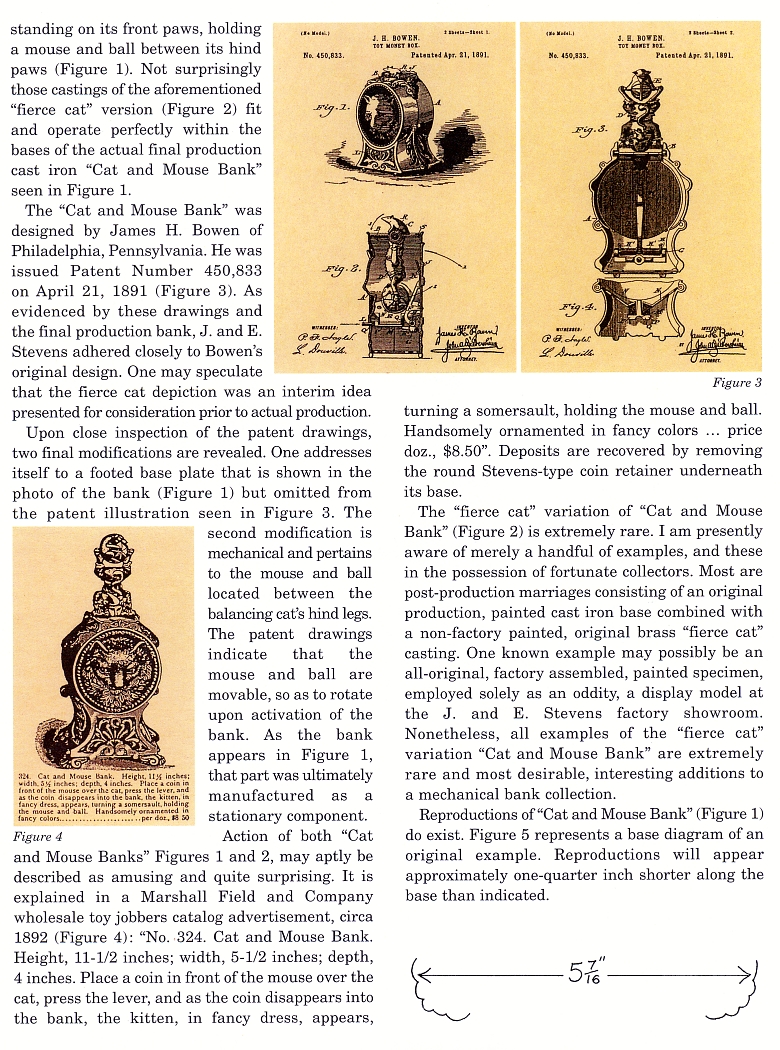|
The Cat and Mouse Bank — Part 2
Fierce, Standing cat Variation
by Sy Schreckinger – ANTIQUE TOY WORLD Magazine – June, 2009
“The game of cat and mouse” — indeed a well-worn
expression — exemplifies the fear and aggressiveness of two of nature's
creatures. Multitudes of anecdotes and fables have been written depicting
their oppositional relationship.
In most instances, however, when directed towards entertaining
children, such scenarios are presented in a light and humorous manner. An
example is an animated cartoon in which the antics of its characters, "Tom
and Jerry", have delighted and amused youngsters. Children squeal with anticipation when the cat named
Tom, portrayed as a buffoon, pursues the wily mouse known as Jerry.
Despite a multitude of precarious situations, Jerry emerges unscathed
while Tom is not only unsuccessful, but also totally humiliated.
The "Cat and Mouse Bank" (Figure 1) may very well be considered the
Tom and Jerry of the nineteenth century. Certainly, this similarity can
only be attributed to its frolicsome and humorous aspects with no serious
threats intended. However, in marked contrast to this version is the fact
that, during the final stages of pattern creation at the J. and E. Stevens
Company, the bank's manufacturer, a very different version of this
mechanical was proposed, one that was grisly and frightening. Evidence
revealing the aforementioned was uncovered several years ago, circa 1950,
during the dismantling of the defunct J. and E. Stevens Foundry.
At that time several brass parts for the "Cat and Mouse Bank" were
discovered. These particular castings presented an image of a
fearsome-appearing cat grasping a captured mouse within its jaws (Figure
2). Understandably, it was decided that this gruesome situation was not
suitable for youngsters and should not be utilized in the final production
stages of "Cat and Mouse Bank". Instead, the mechanical portrayed a cat
dressed as a clown standing on its front paws, holding a mouse and ball
between its hind paws (Figure 1). Not surprisingly those castings of the
aforementioned "fierce cat" version (Figure 2) fit and operate perfectly
within the bases of the actual final production cast iron "Cat and Mouse
Bank" seen in Figure 1.
The "Cat and Mouse Bank" was designed by James H. Bowen of
Philadelphia, Pennsylvania. He was issued Patent Number
450,833 on April
21, 1891 (Figure 3). As evidenced by these drawings and the final
production bank, J. and E. Stevens adhered closely to Bowen's original
design. One may speculate that the fierce cat depiction was an interim
idea presented for consideration prior to actual production.
Upon close inspection of the patent drawings, two final modifications
are revealed. One addresses itself to a footed base plate that is shown in
the photo of the bank (Figure 1) but omitted from the patent illustration
seen in Figure 3. The second modification is mechanical and pertains to the
mouse and ball located between the balancing cat's hind legs. The patent
drawings indicate that the mouse and ball are movable, so as to rotate
upon activation of the bank. As the bank appears in Figure 1, that part
was ultimately manufactured as a stationary component.
Action of both "Cat and Mouse Banks" Figures 1 and 2, may aptly be
described as amusing and quite surprising. It is explained in a Marshall
Field and Company wholesale toy jobbers catalog advertisement, circa 1892
(Figure 4): "No. 324. Cat and Mouse Bank. Height, 11-1/2 inches; width,
5-1/2 inches; depth, 4 inches. Place a coin in front of the mouse over the
cat, press the lever, and as the coin disappears into the bank, the
kitten, in fancy dress, appears, turning a somersault, holding the mouse
and ball. Handsomely ornamented in fancy colors ... price doz., $8.50".
Deposits are recovered by removing the round Stevens-type coin retainer
underneath its base.
The "fierce cat" variation of "Cat and Mouse Bank" (Figure 2) is
extremely rare. I am presently aware of merely a handful of examples, and
these in the possession of fortunate collectors. Most are post-production
marriages consisting of an original production, painted cast iron base
combined with a non-factory painted, original brass "fierce cat" casting.
One known example may possibly be an all-original, factory assembled,
painted specimen, employed solely as an oddity, a display model at the J.
and E. Stevens factory showroom. Nonetheless, all examples of the "fierce
cat" variation "Cat and Mouse Bank" are extremely rare and most desirable,
interesting additions to a mechanical bank collection.
Reproductions of "Cat and Mouse Bank" (Figure 1) do exist. Figure 5
represents a base diagram of an original example. Reproductions will
appear approximately one-quarter inch shorter along the base than
indicated.
|


